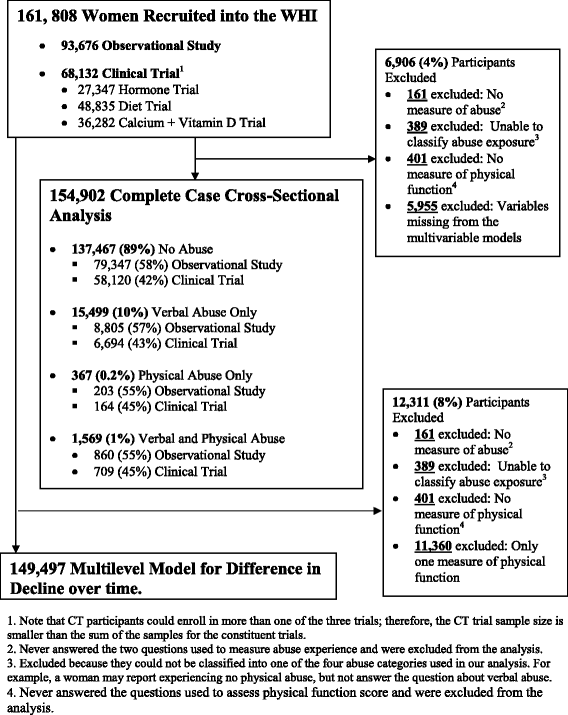Cross-sectional and longitudinal risk of physical impairment in a cohort of postmenopausal women who experience physical and verbal abuse
- PMID: 26554450
- PMCID: PMC4641397
- DOI: 10.1186/s12905-015-0258-2
Cross-sectional and longitudinal risk of physical impairment in a cohort of postmenopausal women who experience physical and verbal abuse
Abstract
Background: Exposure to interpersonal violence, namely verbal and physical abuse, is a highly prevalent threat to women's health and well-being. Among older, post-menopausal women, several researchers have characterized a possible bi-directional relationship of abuse exposure and diminished physical functioning. However, studies that prospectively examine the relationship between interpersonal abuse exposure and physical functioning across multiple years of observation are lacking. To address this literature gap, we prospectively evaluate the association between abuse exposure and physical functioning in a large, national cohort of post-menopausal women across 12 years of follow-up observation.
Methods: Multivariable logistic regression was used to measure the adjusted association between experiencing abuse and physical function score at baseline in 154,902 Women's Health Initiative (WHI) participants. Multilevel modeling, where the trajectories of decline in physical function were modeled as a function of time-varying abuse exposure, was used to evaluate the contribution of abuse to trajectories of physical function scores over time.
Result: Abuse was prevalent among WHI participants, with 11 % of our study population reporting baseline exposure. Verbal abuse was the most commonly reported abuse type (10 %), followed by combined physical and verbal abuse (1 %), followed by physical abuse in the absence of verbal abuse (0.2 %). Abuse exposure (all types) was associated with diminished physical functioning, with women exposed to combined physical and verbal abuse presenting baseline physical functioning scores consistent with non-abused women 20 years senior. Results did not reveal a differential rate of decline over time in physical functioning based on abuse exposure.
Conclusions: Taken together, our findings suggest a need for increased awareness of the prevalence of abuse exposure among postmenopausal women; they also underscore the importance of clinician's vigilance in their efforts toward the prevention, early detection and effective intervention with abuse exposure, including verbal abuse exposure, in post-menopausal women. Given our findings related to abuse exposure and women's diminished physical functioning at WHI baseline, our work illuminates a need for further study, particularly the investigation of this association in younger, pre-menopausal women so that the temporal ordering if this relationship may be better understood.
Similar articles
-
Is Interpersonal Abuse Associated with Sexual (Dis)satisfaction among Postmenopausal Women?Womens Health Issues. 2019 Jul-Aug;29(4):299-307. doi: 10.1016/j.whi.2019.05.009. Epub 2019 Jul 2. Womens Health Issues. 2019. PMID: 31277914 Free PMC article.
-
Psychosocial effects of physical and verbal abuse in postmenopausal women.Ann Fam Med. 2010 May-Jun;8(3):206-13. doi: 10.1370/afm.1095. Ann Fam Med. 2010. PMID: 20458103 Free PMC article.
-
Prevalence and 3-year incidence of abuse among postmenopausal women.Am J Public Health. 2004 Apr;94(4):605-12. doi: 10.2105/ajph.94.4.605. Am J Public Health. 2004. PMID: 15054013 Free PMC article.
-
The Women's Health Initiative trial and related studies: 10 years later: a clinician's view.J Steroid Biochem Mol Biol. 2014 Jul;142:4-11. doi: 10.1016/j.jsbmb.2013.10.009. Epub 2013 Oct 27. J Steroid Biochem Mol Biol. 2014. PMID: 24172877 Review.
-
[Clinical study of the month. Benefit/risk balance of postmenopausal estrogen-progestin treatment in peril in the Women's Health Initiative study: practical attitude of the clinician].Rev Med Liege. 2002 Aug;57(8):556-62. Rev Med Liege. 2002. PMID: 12405030 Review. French.
Cited by
-
Interpersonal trauma and aging-related genitourinary dysfunction in a national sample of older women.Am J Obstet Gynecol. 2019 Jan;220(1):94.e1-94.e7. doi: 10.1016/j.ajog.2018.09.026. Epub 2018 Sep 28. Am J Obstet Gynecol. 2019. PMID: 30273583 Free PMC article.
-
Association of Health Conditions and Health Service Utilization With Intimate Partner Violence Identified via Routine Screening Among Middle-Aged and Older Women.JAMA Netw Open. 2020 Apr 1;3(4):e203138. doi: 10.1001/jamanetworkopen.2020.3138. JAMA Netw Open. 2020. PMID: 32315066 Free PMC article.
-
Is Interpersonal Abuse Associated with Sexual (Dis)satisfaction among Postmenopausal Women?Womens Health Issues. 2019 Jul-Aug;29(4):299-307. doi: 10.1016/j.whi.2019.05.009. Epub 2019 Jul 2. Womens Health Issues. 2019. PMID: 31277914 Free PMC article.
-
Detection of Elder Abuse Through Emergency Care Technicians Screening Tool Revision for Home-Based Primary Care (DETECT-RPC): a cluster randomised controlled trial study protocol.BMJ Open. 2025 Jan 15;15(1):e089028. doi: 10.1136/bmjopen-2024-089028. BMJ Open. 2025. PMID: 39819945 Free PMC article.
-
A scoping review of measurement of violence against women and disability.PLoS One. 2022 Jan 31;17(1):e0263020. doi: 10.1371/journal.pone.0263020. eCollection 2022. PLoS One. 2022. PMID: 35100320 Free PMC article.
References
-
- Black MC, Basile KC, Breiding MJ, Smith SG, Walters ML, Merrick MT, Chen J, Stevens MR. National Center for Injury and Violence Prevention and Control, Centers for Disease Control and Prevention. 2011. The National Intimate Partner and Sexual Violence Survey (NISVS): 2010 summary report.
-
- Tjaden PG, Thoennes N. Extent, nature, and consequences of intimate partner violence. Washington, DC: US Department of Justice, Office of Justice Programs, National Institute of Justice; 2000.
-
- Greenfeld L, Rand M, Craven D, Perkins C, Ringel C, Warchol G, Maston C, Fox JA. Violence by intimates: Bureau of Justice Statistics Factbook. United States Department of Justice, Office of Justic Programs; 1998. p. 49. http://bjs.gov/content/pub/pdf/vi.pdf. Accessed 30 Oct 2015.
-
- Rennison CM. Intimate partner violence and age of victim, 1993–99. United States Department of Justice, Office of Justic Programs; 2001. p. 12.http://www.bjs.gov/content/pub/pdf/ipva99.pdf. Accessed 30 Oct 2015.
Publication types
MeSH terms
Grants and funding
- HHSN268201100001I/HL/NHLBI NIH HHS/United States
- HHSN271201100004C/PHS HHS/United States
- HHSN268201100001C/PHS HHS/United States
- HHSN268201100004I/HL/NHLBI NIH HHS/United States
- HHSN268201100046C/HL/NHLBI NIH HHS/United States
- HHSN268201100003C/WH/WHI NIH HHS/United States
- HHSN268201100003C/PHS HHS/United States
- HHSN268201100004C/PHS HHS/United States
- P30 AG028740/AG/NIA NIH HHS/United States
- HHSN271201100004C/AG/NIA NIH HHS/United States
- HHSN268201100002C/WH/WHI NIH HHS/United States
- HHSN268201100046C/PHS HHS/United States
- HHSN268201100002I/HL/NHLBI NIH HHS/United States
- HHSN268201100002C/PHS HHS/United States
- HHSN268201100001C/WH/WHI NIH HHS/United States
- HHSN268201100004C/WH/WHI NIH HHS/United States
LinkOut - more resources
Full Text Sources
Other Literature Sources
Medical
Miscellaneous


